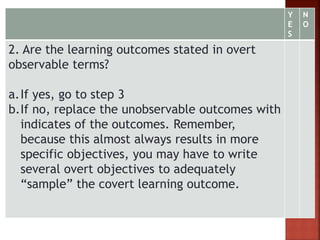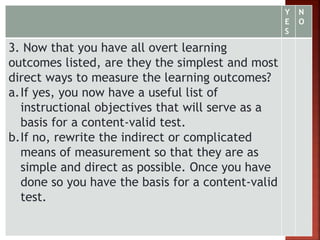Identfying test objecctives (Assessment and Evaluation)
- 1. Ero dela Vega III-21 BSE Biology
- 2. Instructional objective: - a concise statement of the skill that you student will be expected to perform after a unit of instruction.
- 3. 1. Observable learning outcome 2. Any special conditions under which the behavior must be displayed, and 3. The performance level considered to be indicative of mastery.
- 5. Learning outcomes: - Learning outcomes are statements of a learning achievement and are expressed in terms of what the learner is expected to known understand and be able to do on completion of the award or module.
- 6. By the end of the semester the child will identify pictures of words that sound alike. ŌĆ£Learning OutcomesŌĆØ
- 7. The child will demonstrate an appreciation of poetry. ŌĆ£Learning outcomesŌĆØ
- 8. The student will subtract one digit numbers with 80% accuracy. ŌĆ£Learning OutcomesŌĆØ
- 9. Learning Activities: - Activities that enable the student(s), through observation or participation, to achieve the learning objectives. - Means that lead to a learning outcome
- 10. The student will practice the multiplication tables. ŌĆ£Learning activitiesŌĆØ
- 11. The student will dance ŌĆ£Love on Top.ŌĆØ ŌĆ£Learning ActivitiesŌĆØ
- 12. Learning outcomes should describe ŌĆ£the results of the learning rather than the learning process itselfŌĆØ. Action verbs in learning outcomes should convey precisely the core of the outcome.
- 13. All learning outcome statements should: - be as simple as possible - be of maximum relevance and utility - communicate clearly what a learner is expected to achieve - relate to previous ŌĆ£levelŌĆØ of learning outcome statements.
- 15. ŌĆ£The student will show a knowledge of punctuation.ŌĆØ ŌĆ£Immeasurable, and unobservable learning outcomeŌĆØ
- 16. Instructional objectives are specific, measurable statements of the outcomes of instructions that indicate whether instructional intents have been achieved.
- 17. OBSERVABLE UNOBSERVABLE a.List b.Recite c.Change d.Draw a.Value b.Appreciate c.Know d.Understand
- 18. Circle the initial sound of words. - Observable Be familiar with the law. - Unobservable Add two digit numbers on paper. - Observable
- 19. Appreciate art decoration. - Unobservable Really understand set theory - Unobservable Recite the names of the character in Tom Sauyer. - Observable
- 21. An instructional objective describes any special conditions in which the learning will take place. Conditions must be stated explicitly in the objective if the observable learning outcome take place at a particular time, place with particular materials.
- 22. Given a calculator, multiply two-digit number correct to the nearest whole number . Given a typed list, correct any typographical errors. Given a list of six scrambled words, arrange the words to form a sentence.
- 24. An instructional objective indicates how well the behavior is to be performed. The criterion level of acceptable performance specifies how many of these items the student must get correct for him or her to have passed the objective.
- 25. Given 20 two-digit number, the student will compute all answers correctly. Given 20 two digit addition problems, the student will compute 90% correctly.
- 26. Remember, criterion levels need not always be specified in terms of percentages items answered correctly: a. number of items correct b. number of consecutive items correct c. essential features included d. completion within a prescribed time limit
- 28. YES NO 1.Are the objectives composed of only learning outcomes, and not learning activities? a.If yes, go to Step 2 b.If no, eliminate the learning activities or replace them with the learning outcomes.
- 29. Y E S N O 2. Are the learning outcomes stated in overt observable terms? a.If yes, go to step 3 b.If no, replace the unobservable outcomes with indicates of the outcomes. Remember, because this almost always results in more specific objectives, you may have to write several overt objectives to adequately ŌĆ£sampleŌĆØ the covert learning outcome.
- 30. Y E S N O 3. Now that you have all overt learning outcomes listed, are they the simplest and most direct ways to measure the learning outcomes? a.If yes, you now have a useful list of instructional objectives that will serve as a basis for a content-valid test. b.If no, rewrite the indirect or complicated means of measurement so that they are as simple and direct as possible. Once you have done so you have the basis for a content-valid test.
































